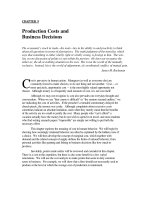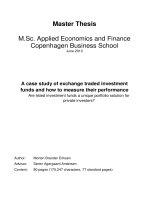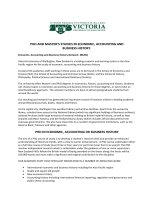Finance and business planning
Bạn đang xem bản rút gọn của tài liệu. Xem và tải ngay bản đầy đủ của tài liệu tại đây (853.86 KB, 59 trang )
Keys to Financing the New Venture
Alec Johnson, Ph.D.
University of St. Thomas
The Problem
“Small business management is cash flow
management.” Dr. Robert Pricer, Weinert Applied Ventures Program, Unviersity of
Wisconsin
“Cash is King.” Dave Stassen, Partner, St. Paul Venture Capital
“You’re not an entrepreneur until you’ve written payroll
checks on Friday and spent the weekend collecting the
cash to cover them.” Keith Streckenbach, founder and CEO of
PharmacyOneSouce.com
Entrepreneurial Finance vs.
Corporate Finance
Differences from Corporate Finance
–
Diversification and Value
–
Involvement of Investors
–
Harvesting
The Problem - Objectives
Minimize Cost Maximize
Return
Maintain
Control
Maximize
Ownership
Minimize
Involvement
Minimize Risk
Entrepren
eur
Investor
The Problem - Management
What is the Ultimate Task of an Entrepreneur?
•
Job #1 is Risk Management
•
Largest risk is Financial and question
becomes “How?”
The Problem - Structure
Type, i.e. Do I use debt, equity or some
combination.
Timing, i.e. When do I need it?
Amount, i.e. How much do I need?
Type – Two General Classes
Debt
–
Represents a fixed cost
–
Represents more risk
–
Cheapest type of outside
financing
Equity
–
No interest payment
–
No obligation to repay
–
Most Expensive type of
financing
Sources of Debt Financing
Friends and Family
Banks
Leasing
Factoring
Bank Financing
Commercial banks are the largest source of
external capital for growing firms.
Problems:
–
Lack of collateral
–
Lack of earnings history
Leasing
Often used technique to acquiring assets without
having to purchase them.
Two types of Leases:
–
Operating Lease
–
Capital Lease
Factoring
Factors buy company’s accounts receivables at
a discount.
Recall R&R case.
Gets cash to company quickly, but must have
cost of factor available in profit margin.
Equity
When to use equity?
–
Every company has some form of equity.
–
Founders raise equity when:
•
there is no collateral to secure debt
•
insufficient cash flow to secure debt
•
required growth capital more than banks can provide.
Types of Equity Instruments
Typically used in small business placements:
–
Common Stock
–
Preferred Stock
Types of Equity Instruments
Common Stock Characteristics:
–
Most common form of issuance
–
Last in liquidation = ?
–
Represents Entire ownership of firm.
Types of Equity Instruments
Preferred Stock Characteristics:
–
Pays dividends
–
Preference in liquidation
Types of Equity Instruments
Preferred Stock Characteristics:
–
Looks a lot like Debt!
–
Used by Venture Capitalists to gain position in
liquidity event while minimizing risk.
Types of Equity Investors
Angel Investors
Venture Capitalists
Types of Equity Investors: Angels
Typical Angel Investor
–
Private individual (not an institutional fund)
–
Age: 47 –54 years
–
Gender: Male
–
Net Worth: $1,000,000 +
Types of Equity Investors: Angels
Typical Angel Investor
–
Education: Bachelors or greater
–
Average Investment: $59,000
–
Preferred Stage: Start-up (56%) and infant or
young (24%)
Types of Equity Investors: Angels
Typical Angel Investor
–
Required Rate of Return: 15% - 45%
–
Length of Investment 3 – 10 years
–
“Patient Money”
Types of Equity Investors: Venture
Capital
Typical Venture Capital Firms
–
Institutional Firm
–
Raises money from various sources, including Angels
–
Creates “pool” of capital, a fund.
–
Develops portfolio of firms under management
Types of Equity Investors: Venture
Capital
Typical Venture Capital Firms
–
Average Investment: $1 M to $50 M per investment.
–
Industries: High Growth, early or later stages
–
Services Provided: None to direct management decision
making and board control.
–
Required Rate of Return: 10X in 3-5 years.
–
Typically invest using Preferred Stock
Venture Capital Investments, Q2 2001
2.2% of Venture Capital invested in Midwest!
0
5
10
15
20
25
30
Communications
and Networking
Consumer and
Business
Services
Biopharm Semiconductors Med Sftwr Retailers Consumer &
Bus.
Dollars
Share
Timing – Sources of New Venture
Financing*
Development Start-Up Early
Growth
Rapid Growth Exit
Entrepreneur/
Friends/Family
Angels/Partner
Banks/Lessors
Venture Capital
IPO
*Adapted from: Smith and Smith, Entrepreneurial Finance, 2000
Timing - Cash Needs
Goal is to manage risk to business and to
investor.
Minimize risk by staging investments
Establish stages by developing solid business
plan and financial projections!









